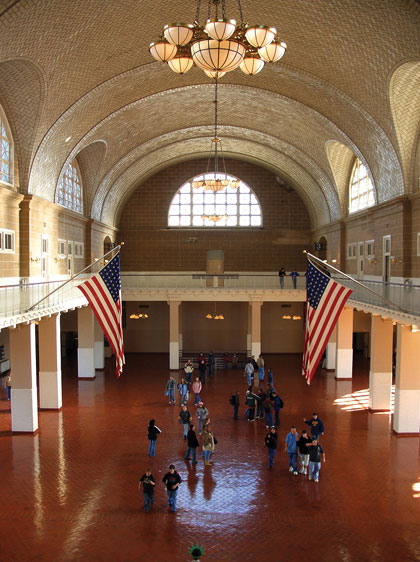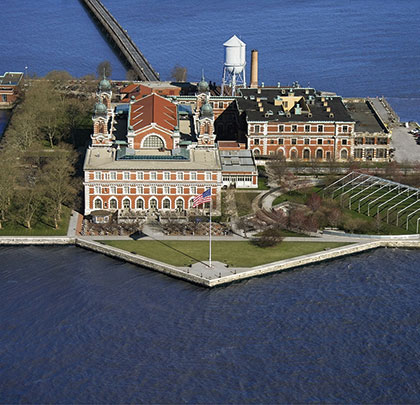Ellis Island, in the shadow of the Statue of Liberty, is one of America’s most popular historic sites. The island is one of a number of small, naturally occurring islands in New York Harbor. Over many years, this island—which for millions of people represented the gateway to the New World—was enlarged from its original 3.3 acres to its current 27.5 acres by adding landfill from ships ballast and possibly excess earth from the construction of the New York City subway system.
The island was not always a point of entry for immigrants or a tourist destination. By the time it was purchased in the 1770s by Samuel Ellis, it had served as a hanging site for pirates, a harbor fort, and an ammunition and ordinance depot. The U.S. Government purchased the island from New York State in 1808. Just before the War of 1812 broke out a series of structures were erected that served as a defense system for New York Harbor. Ellis Island was approved as a site for fortifications and on it was constructed a parapet of three tiers of circular guns.

ELLIS ISLAND ESTABLISHED AS AN IMMIGRATION STATION
In January 1892 the federal government took over the processing of immigrants from the states and opened a new immigration station on Ellis Island. Over the next sixty-two years more than twelve million immigrants were processed at the site. Approximately 1.25 million of those came in 1907 alone. Consequently, carpenters and masons were constantly working to enlarge and build new hospitals, dormitories and kitchens and the island’s facilities were rapidly expanded between 1900 and 1915.
Immigration decreased as the United States entered World War I and during this time the island was taken over by the U.S. Navy and the Army Medical Department. In 1920 Ellis Island reopened as an immigration receiving station. However, after World War I immigrants applied for visas at American consulates in their country of origin. After 1924 the only immigrants passing through Ellis Island were those who had problems with their paperwork, war refugees and displaced people. In 1954 the last detainee was released and Ellis Island officially closed.
In 1965 President Lyndon Johnson declared Ellis Island part of the Statue of Liberty National Monument. Between 1976 and 1984 Ellis Island was opened to the public on a limited basis. In 1984 Ellis Island underwent a major restoration—the largest historic restoration in U.S. history.
This was the historic foundation upon which the modern infrastructure of Ellis Island was built. In recent years the island has become one of the most popular tourist destinations in the National Park Service. That means a lot of visitors and the need for well working infrastructure.
On October 28, 2012, Hurricane Sandy swept over Ellis Island, Liberty Island, and much of the East Coast. The Ellis Island Immigration Museum reopened on a limited basis one year later, but repairs to the buildings and infrastructure would continue for many months.
Although the damage to Ellis Island was extensive, the island’s antiquated sewage system was fraught with problems long before Hurricane Sandy came ashore. At that time, New Jersey-based Pump Express Services had been providing maintenance to the island’s sewage ejector system for a couple of years.
According to Pump Express sales manager Fred Hettinger, in the two years before Sandy they were called to the island numerous times in response to high water alarms, clogging and ultimately a failed pump. “They had a two-pump system and when one pump failed they let the system run on the other,” he says. Then, the second pump failed “and they had nothing.”
Hettinger explained that a significant problem was that the old pumps were a simple ejector type and didn’t break down solids. Along with the sewage flow on the island there was also a significant amount of debris—with synthetic fibers being particularly problematic—that routinely clogged the system.
In addition to the clogging problem, physically getting to the pumps in order to service them was a lengthy and labor-intensive ordeal. “The old system required four techs and an entire day to service a clog. A man had to physically descend into the 30-foot pit to detach and later reattach the pump,” Hettinger says.
Left with only minimal sewage disposal, and faced with a grand reopening to the public targeted for July 4th, 2013, the island’s maintenance engineers reached out again to Pump Express Services—this time for a more permanent solution.

BJM’S SK SERIES ELECTRIC SUBMERSIBLE SHREDDER PUMPS GET SYSTEM BACK ON LINE
“We submitted a proposal to replace the old pump system with a pair of 15 horsepower BJM shredders,” Hettinger says. “We’ve been using BJM shredders for four or five years now and everything we’ve been able to throw at them they’ve been able to handle.”
In addition, Pump Express proposed replacing two 20-foot (6.1 meter) sections of steel pipe, along with discharge and base elbows, installing a more efficient rail system and resurfacing the base of the sewage pit. Instead of four techs and an entire day, the new system can be serviced by two techs in four hours. The two new BJM shredders lent themselves well to this new configuration.
If a customer is ordering a new pump it’s likely because the one they have has failed or is about to. Hettinger said that an important additional benefit of ordering the BJM Pumps was that the lead time for their delivery was about half of what it would have been for new ejector pumps equivalent to the ones that had failed. He said that was impressive considering “all this stuff has to be built. A lot of times the parts still have to be manufactured.” The BJM pumps were delivered in about four weeks. The estimated delivery time for the ejector pumps had been ten weeks.
In April 2013 Pump Express installed a pair of 900-pound (408.2 kilogram) BJM SK Series shredder pumps into the revamped Ellis Island system. The pumps can handle 845 gallons (3198.7 liters) per minute of wastewater at heads of up to 94 feet (28.7 meters).
The SK Series pumps were chosen specifically because they are designed to shred solids before passing the liquid. The shredder pumps leave solids slightly larger than if they were passed through a grinder pump. The shredding action is produced through use of a unique FangTM non-clog cutting impeller with tungsten carbide vane tips against a high-chrome “tooth shaped” diffuser plate. The cutting tips shred solids against the pump suction plate, continuously ripping the solids apart with 360-degree shredding action. The SK Series shredder pump works on many objects that would clog an ordinary pump.
Other quality features built into the SK Series pumps that supported their recommendation for the Ellis Island installation include the following.
- The 304 stainless steel motor housing helps protect the pumps from abrasion and premature wear caused by the harsh saltwater environment.
- The motor is protected by double mechanical seals. The lower seal is made of silicon carbide/silicon carbide and the upper seal is made of carbon/ceramic. In addition, a lip seal has been installed above the impeller that helps prevent abrasives, such as sand, from entering the seal chamber.
- Winding protection and NEMA Class F motor insulation allow the motor temperature to rise to 230 degrees Fahrenheit (110 degrees Celsius). An automatic switch turns the pump motor off if the temperature and/or amp draw gets too high. When the motor cools the switch will automatically reset and the pump will restart.
- A hardened cast iron exterior stands up to rough handling and pumping of sandy water unlike pumps with soft resin impellers or plastic exterior components. (Specifications may differ between models.)

CONCLUSION
About six months after installation a team from Pump Express went back to Ellis Island to make sure the new pumps were performing as anticipated. “We’re now going on a year and a half and haven’t had any issues,” Hettinger says. That’s a vast improvement over the previous average of a visit every six months. “I bet in the last eighteen months if we had had to go out there three more times it would have cost them half of what the upgrade cost them,” he adds. ■
About the Author
Mike Bjorkman is vice president of BJM Corp. and has more than thirty years of experience in the pump industry. He serves as director of marketing and IT for BJM Pumps, LLC and All Test Pro, LLC. Both companies are subsidiaries of BJM Corp. BJM Pumps, established in 1983, supplies electrical submersible pumps to industrial and municipal markets throughout the United States, Canada and South America. For more information, visit www.bjmpumps.com.
MODERN PUMPING TODAY, December 2014
Did you enjoy this article?
Subscribe to the FREE Digital Edition of Modern Pumping Today Magazine!


